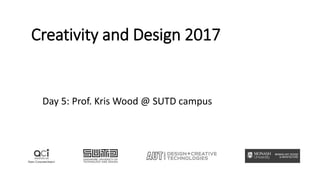Creativity and design 2017 day 4
- 1. Creativity and Design 2017 Day 4: Experience creativity
- 2. Comments from Day 3
- 4. Ideation golden rules 1. Take turns, contribute and let encourage others to contribute 2. Go for quantity: a stream a storm a typhoon of ideas “think aloud” 3. Don’t criticise ideas, avoid any reference to their feasibility at this stage 4. Bad ideas are allowed are welcome are encouraged 5. Practice active listening: rephrase, inquire, build-upon, combine
- 5. Activity 4.1: Brainstorming “Not my problem” problem Duration: 15 minutes
- 6. Ideation recommendations • Introduce/amplify diversity • Explore the problems as well as the solutions • Don’t praise ideas either, accept and “plus” them • Document, capture ideas • Look for gaps in the sequence of ideas, themes, types of ideas • It’s not a competition, it’s not a place to shine, avoid ownership of ideas • Create mutual trust, a safe space: no hierarchies, level playing field • Model the process, walk the talk • Don’t overdo it: 20 minute blocks with breaks • Be mindful of the “second half gain”: less obvious ideas emerge after the box has been defined with commonplace ideas • Don’t expect every session to be successful • Ideation is like Karaoke: https://www.timeout.com/los-angeles/clubs/the-10-rules-of- karaoke
- 7. Morning break Duration: 15 minutes
- 8. Facilitation 1. Questions to ask before a session: Is this necessary? Who should be invited? Where? When? How long? Goals? Outcomes? Resources? Training? Information or prep work required? Agenda? How can I creatively prepare the session? What techniques? What can I prototype about this session? Define the session: explorative, generative, associative, provocative, intuitive… 2. Things to worry about during the session: Is this working? Is the atmosphere conducive? Do we need a break or to stop? Who is missing? What next? Are ideas flowing? Are we learning? 3. Decisions after the session: Document and reflect, share results, next steps, lessons learned, new questions, practice-practice-practice… 4. Recommended: 1. Creative Facilitation, Marc Tassoul, VSSD, Delft (2009): http://www.delftacademicpress.nl/bij/b005extract.pdf 2. The Systems Thinking Playbook: Exercises to Stretch and Build Learning: http://www.chelseagreen.com/the-systems-thinking-playbook
- 9. Ideation methods • SCAMPER • Six hats • 6-3-5 method or C-sketch • Key tools: • Perceptual and mind maps • Morph matrix • Mood boards • Other methods: • Analogy (https://asknature.org) • TIPS/TRIZ • Generative sessions (co- design)
- 11. Activity 4.2: SCAMPER Duration: 15 minutes
- 12. Lunch 1 hour
- 14. Activity 4.3: Six hats Duration: 15 minutes
- 15. Activity 4.4: 6-3-5 method Duration: 30 minutes
- 16. Innovation Tournaments: Creating and Selecting Exceptional Opportunities Book by Christian Terwiesch and Karl Ulrich 101 Design Methods: A Structured Approach for Driving Innovation Book by Vinay Kumar Thinkertoys: A Handbook of Creative-Thinking Techniques Book by Michael Michalko Universal Methods of Design: 100 Ways to Research Complex Problems, ... Book by Bella Martin and Bruce Hanington Convivial Toolbox: Generative Research for the Front End of Design Book by Elizabeth B.-N. Sanders, Liz Sanders, and Pieter Jan Stappers
- 17. Activity 4.5: Idea development and idea evaluation Duration: 15 minutes
- 23. Form, function, meaning in services and products Duration:
- 27. Activity 4.6: Post-survey Duration: 15 minutes Mode: Individual
- 28. Grading • Individual: • Class participation: 10% • End of Session Activities: 20% • Final Reflection (Individual): 40% • Team: • Final Reflection (Team): 30% • Total: 100%
- 29. Individual Report Weight: 40% Due: Sunday 02 April noon
- 30. Individual report 1. Explain in your own words the most important lessons learned during this module (suggested: 3) 2. Choose one and apply it in your workplace (alternatively at home) 3. Reflect on what happened: what was successful, what failed, what did you learn, what may you do next, etc. 4. Free format, free extension. Keep a high standard of quality, communication, and integrity 5. Build strong arguments and robust decisions (connect to context: references to studies, published experts’ advice, case studies, statistics, etc.) 6. Submit your report as a pdf file to: rsosa@aut.ac.nz with “ACI Individual Report” and your name in the Subject of the email 7. Hard deadline: Sunday 02 April noon
- 31. Individual report Grading rubric: 1. Accuracy of the concepts, ideas, techniques learned in the module 2. Clarity of communication: grammar, spelling, presentation 3. Effort in applying at least one key idea learned in the module to your job 4. Original contributions and authoritative connections to the context Each dimension is ranked on a scale of 100
- 32. Team Report Weight: 30% Due: Sunday 09 April noon
- 33. Team report • Once you have submitted your individual report to us, arrange to share it with one or two classmates. In exchange, read their individual reports • The team report is a joint co-authored reflection of your experiences: • Your learning experiences during and after the module • Your experiences applying your new ideas/skills/initiatives at work • What was similar/different, what stood out, how does their work inform yours, what feedback/advice can you give them? • Hard deadline: Sunday 09 April noon
- 34. Team report Grading rubric: 1. Evidence of meaningful discussion and understanding each other’s work 2. Insightful comparisons, conclusions, questions built collaboratively 3. Critical and constructive feedback to teammates (not trivial praising) Each dimension is ranked on a scale of 100
- 35. Creativity and Design 2017 Day 4: Hands-On!
- 36. Thank you! Keep in touch:
- 37. Creativity and Design 2017 Day 5: Prof. Kris Wood @ SUTD campus
- 38. Alt. DIY Activity • Form “listening triads”, iterate swapping roles • Discussion theme: “Most valuable idea today, and why?” • Write your own key learning, submit before you leave today Active listening Empathize with others Reflect and synthesize






































